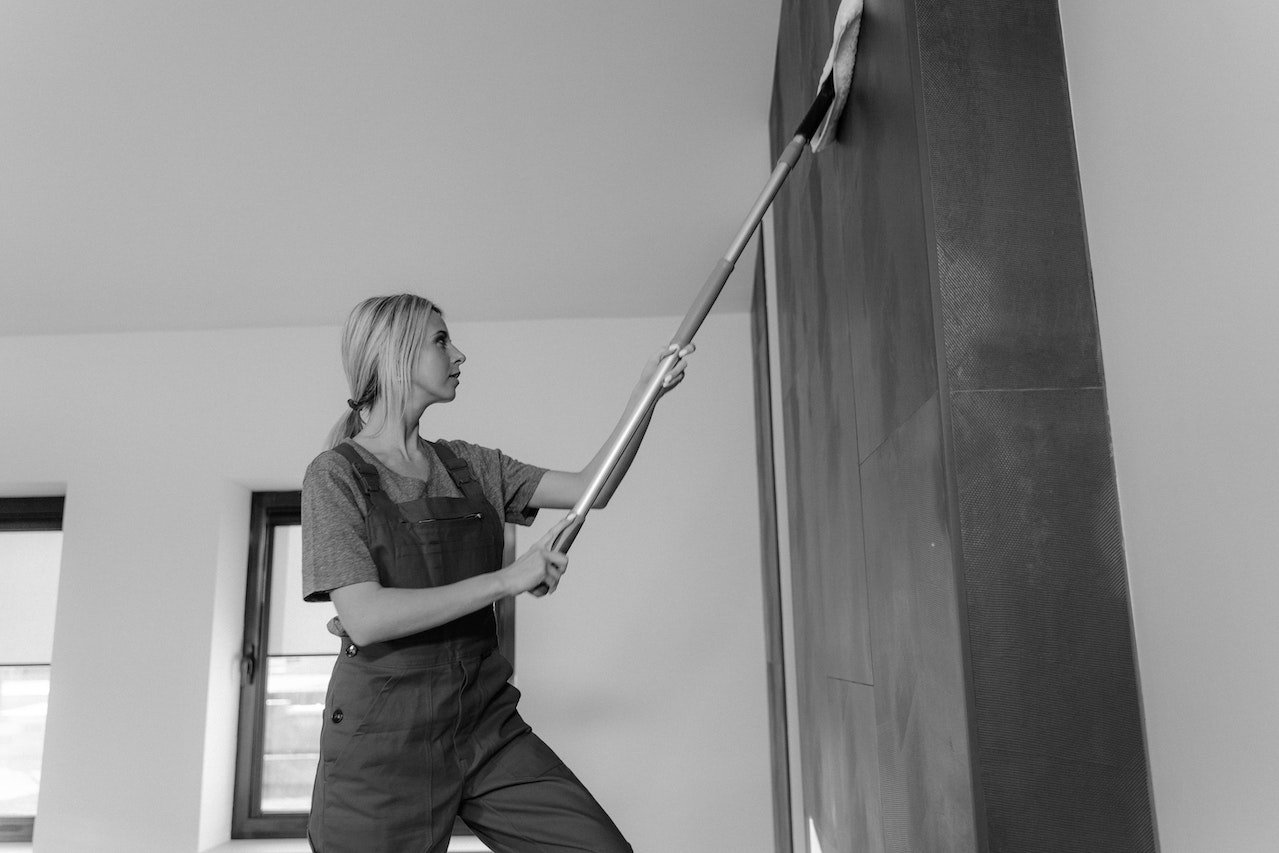4 Wall Cleaning Tips
1. Prepare Walls for Cleaning
Before cleaning walls, it's important to prep them by removing any loose dust, dirt or debris. This prevents smearing stuff around during the actual cleaning process.
Start by using a dry microfiber duster to lightly dust wall surfaces. A Swiffer-style duster on an extendable pole works great for hard to reach areas and ceilings. Be sure to get into corners, along trim, and top edges where dust loves to accumulate.
For more stubborn dust or cobwebs, use a slightly damp microfiber cloth to wipe the area first. This helps capture particles better than a dry cloth. Avoid using too much water, you just want to lightly dampen.
Pay special attention around vents, fans, light fixtures, wall hangings and other areas that tend to collect more dust. Use a small vacuum crevice tool to clean any cracks or crevices.
Finally, use the duster again for a final once over. This removes any remaining fine particles prepped for the real cleaning steps. Proper pre-cleaning prevents dirt from smearing into the wall paint later.
2. Prepare Cleaning Solution
When it comes to the actual cleaning solution, you’ll want to use a gentle cleaner that cuts through typical dirt and grease buildup. Avoid harsh chemicals that could damage or discolor delicate wall paints.
A simple spray bottle with warm water and just a couple drops of mild dish soap like Dawn or Joy works great for most situation. The small amount of degreaser in the soap helps cut through oils, finger marks, and residue without being too abrasive.
For cleaning heavily soiled or greasy kitchen walls, up the cleaning power by substituting half white vinegar for half the water. The acetic acid in vinegar dissolves sticky grease andResidue nicely.
You can use a bucket of cleaning solution and large sponge for large wall expanses. But a spray bottle allows more control for spot cleaning smaller areas. Spray a light mist directly onto the wall or dampen your cleaning cloth.
Never saturate or soak walls with water. Be cautious around wallpaper, delicate surfaces, or cracks. Avoid cleaner contact with electrical outlets, switches or fixtures.
3. Spot Clean Noticeable Stains
Before cleaning walls completely, inspect for any obvious stains or marks that need special attention. Spot treat these areas first.
For crayon, marker, or tougher grease stains, gently rub the spot with a damp baking soda paste using your fingers or a soft cloth. Let it sit briefly, then wipe clean. The mild abrasive quality of baking soda helps lift stubborn marks without harsh scrubbing.
Try dabbing a bit of undiluted dish soap directly on any remaining spots using an old toothbrush or fingertip. Allow to penetrate briefly before lightly scrubbing and rinsing with water. This helps lift deeply set stains.
Magic eraser sponges work well for quickly cleaning marks and scuffs, but use gently. Their melamine foam can damage delicate wall paints if rubbed too aggressively.
Finish spot cleaning by wiping treated areas with your prepared cleaning solution to rinse away any cleaning product residue. Now the walls are ready for an overall cleaning.
4. Gently Wipe Walls with Cleaning Solution
With prep work and spot cleaning finished, it’s time for the satisfying task of wiping down walls completely. Work in sections for the most thorough cleaning.
Use a large microfiber sponge or soft lint-free rag to apply your cleaning solution. Gently wipe in overlapping strokes from top to bottom, rinsing the sponge or cloth frequently.
Work evenly across flat wall expanses. For inside corners or around obstructions, wrap your cloth around your fingers to reach. Switch to a small detail brush to clean along trim or edges.
Take extra care on semi-gloss and flat paints, which can show wipe marks. Rinse your cleaning cloth frequently and wipe gently to avoid pushing around dirt. Wipe slowly and let solution sit briefly on any remaining tough spots.
Continue wiping and rinsing until the entire wall area looks clean. For the final touch, use a fresh microfiber cloth dampened only with clean water. This removes any film left behind by cleaning products.
Thorough wall wipe-downs about once or twice a year keeps them looking fresh in high traffic areas. For quick touch-ups, spot clean smudges as needed. Proper prep and gentleness prevents damaging delicate wall surfaces.
Summary
Cleaning walls effectively starts with proper prepping using dusters to remove loose debris. Make a mild cleaning solution like dilute dish soap and water. Spot clean stubborn stains first with baking soda or undiluted soap if needed. Finally, gently wipe the entire wall in sections using overlapping strokes. Take extra care on flat or semi-gloss paints prone to showing marks. Regular thorough cleanings and prompt spot treatments keeps walls looking their best.

